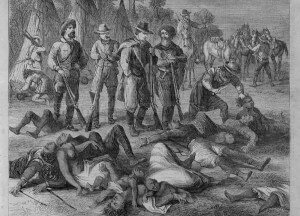In the past 150 years, tens of millions of men, women and children have lost their lives in genocide or mass atrocities. Millions have been tortured, raped or forced from their homes.
The past genocides and mass atrocities described below represent just some of the historic examples that serve to remind us what’s at stake if we let genocide happen again. We must learn, remember and take action to end genocide once and for all.
-
1915
Armenia

Beginning in 1915, ethnic Armenians living in the Ottoman Empire were rounded up, deported and executed on orders of the government.
The combination of massacres, forced deportation marches and deaths due to disease in concentration camps is estimated to have killed more than 1 million ethnic Armenians, Assyrians and Greeks between 1915 and 1923. Learn more »
-
1933
The Holocaust
The Holocaust

After coming to power in 1933, Germany's Nazi Party implemented a highly organized strategy of persecution, murder and genocide aimed at ethnically "purifying" Germany, a plan Hitler called the “Final Solution”.
Six million Jews and five million Slavs, Roma, disabled, Jehovah’s Witnesses, homosexuals, and political and religious dissidents were killed during the Holocaust. Learn more »
-
1975
Cambodia
Cambodia

When the Khmer Rouge took control of the Cambodian government in 1975 they began a "re-education" campaign targeting political dissidents.
These citizens, including doctors, teachers and students suspected of receiving education were singled out for torture at the notorious Tuol Sleng prison.
In the four years after they took power, between 1.7 and 2 million Cambodians died in the Khmer Rouge’s "Killing Fields."
Learn more » -
1990
Rwanda
Rwanda

Civil war broke out in Rwanda in 1990, exacerbating tensions between the Tutsi minority and Hutu majority.
In 1994, returning from a round of talks, Rwandan President Juvenal Habyarimana was killed when his plane was shot down outside of the country’s capital, Kigali.
Habyarimana’s death provided the spark for an organized campaign of violence against Tutsi and moderate Hutu civilians across the country. Learn more »
-
1995
Bosnia
Bosnia

Beginning in 1991, Yugoslavia began to break up along ethnic lines.
When the republic of Bosnia and Herzegovina (Bosnia) declared independence in 1992 the region quickly became the central theater of fighting.
The Serbs targeted Bosniak and Croatian civilians in areas under their control in a campaign of ethnic cleansing. The war in Bosnia claimed the lives of an estimated 100,000 people.
Learn more » -
2003
Darfur
Darfur

Over a decade ago the Government of Sudan carried out genocide against Darfuri civilians, murdering 300,000 & displacing over 2 million people.
In addition to the ongoing crisis in Darfur, forces under the command of Sudanese President Omar al-Bashir have carried out attacks against civilians in the disputed Abyei territory, and the states of South Kordofan and Blue Nile. Learn more »
Atrocities Against Native Americans
 For hundreds of years a mixture of colonial conflict, disease, specific atrocities and policies of discrimination has devastated the Native American population. In the course of this time, it is estimated that over nine million Natives died from violent conflict or disease. For too long this history has been under-recognized and too little discussed.
For hundreds of years a mixture of colonial conflict, disease, specific atrocities and policies of discrimination has devastated the Native American population. In the course of this time, it is estimated that over nine million Natives died from violent conflict or disease. For too long this history has been under-recognized and too little discussed.
Today there are over 500 Native American tribes in the United States, each with a distinct culture, way of life and history. Even today, Native Americans face large challenges to cope with the disadvantages history has left them and ongoing cases of discrimination.


